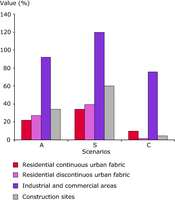
Development and economic growth with less urban sprawl — simulation of urban land‑use development in the Algarve region (Portugal)
Different scenarios for regional development to 2020 have been simulated to evaluate the impacts of economic trends and spatial policies on land use:
• Scenario A Business as usual: continuation of current conditions, where agriculture, fisheries and tourism are the main economic activities. Internal demographic movements are the major drivers of land‑use changes. GDP increases by 2.9% per year.
• Scenario S Scattered development: urban land-take is the result of high population growth, especially due to the influx of tourists, and economic growth both in the industrial and service sectors. Increase in GDP is twice that in Scenario A at 6 %.
• Scenario C Compact development: spatial policies and restrictive planning aim at concentrating urbanisation in designated areas. GDP growth is as in Scenario S, 6 %.